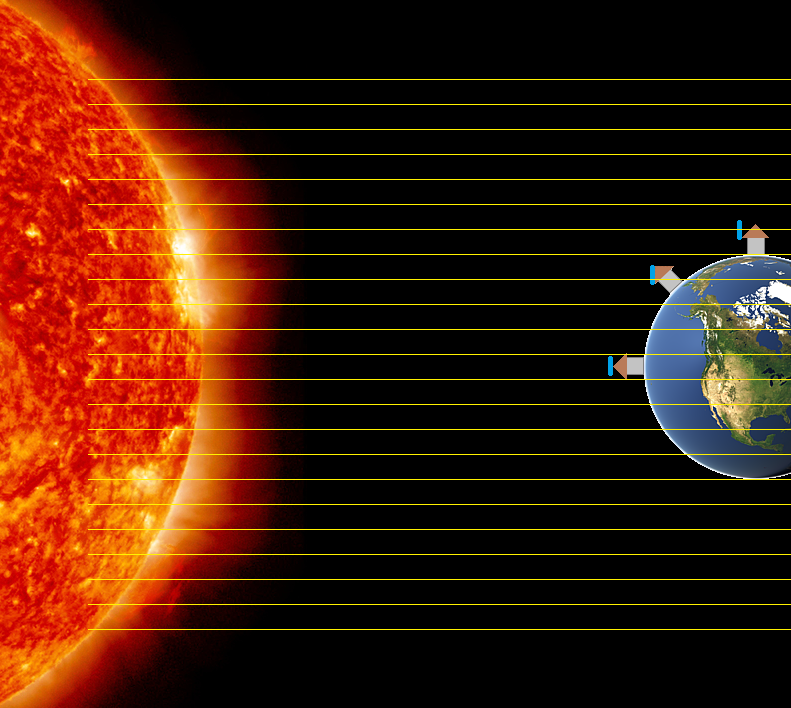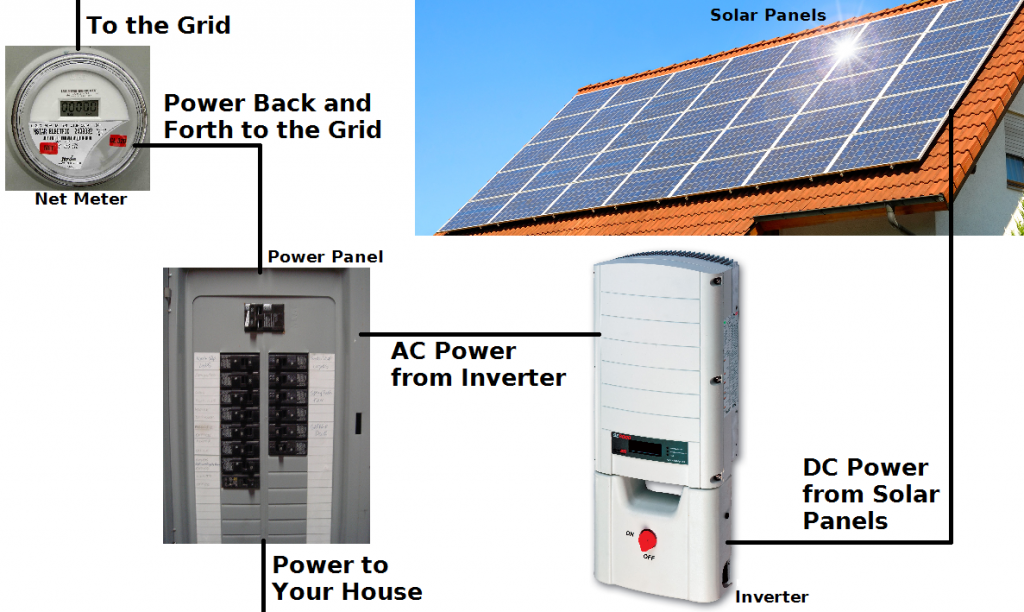How Solar Works
This is a somewhat technical description of how solar panels work to power your house. If you would rather just read about how I got solar panels for my house instead of how solar panels work, you should head over and read my Solar Energy Spill post.
Every good description about how solar works starts with the sun. Since the idea is to take energy the sun is pouring out and to claim some of it as your own, it stands to reason that the sun is a good place to start. First you must consider that the sun does not just follow the exact same line through the sky every day. In fact, it doesn’t even follow the same line through the sky based on where on Earth you are watching it from. Add to that the tidbit about how even from the same place (your house for example) the sun traces a different path depending on what time of year it is. All this means that there is a little bit of math involved in making sure your solar panels are pointing the right way to capture as much sun as possible.
First, imagine the sun lives in a specific direction from the Earth. (Which of course it does, so it shouldn’t be hard to imagine.) Now add to that mental picture that the sun is more or less actually over the equator. That means if you live in the northern hemisphere, the sun doesn’t actually travel directly over your head during the day. Sure, it may seem that way, and expressions like “high noon” seem to back that up, but it actually travels through the sky to the south of your house. This in turn means that you want to put solar panels on something that faces south.
So now we’ve established that the northern hemisphere means south facing panels, but how much south? I mean the sun is definitely to the south, but it’s also definitely way up in the sky. This means the angle you point your panels to the south matters. Worse, there is a difference between “true south” and “magnetic south”. Where I live, the angle of my roof works very well, but in other places it is better to put them on funny brackets that make them point at a better angle. As it turns out there is a name for this angle. It’s simply called your latitude.
If you think about this whole equator, sun up in the sky, hemisphere thing you can draw a couple of cool conclusions. At the equator, your latitude is 0 degrees. That means the sun travels almost directly over your house, which means you want your panels to point straight up. Which makes the best possible roof angle perfectly flat (parallel to the ground). A flat roof has an angle of 0 degrees. Look at that, 0 degrees latitude, 0 degrees roof angle, 0 for both, so far this theory holds. Now imagine the other extreme and pretend you live on the north pole. For you, the sun is always extremely in the south since the sun is following a line all the way down by the equator. In fact, it’s so far to the south that the best possible angle for your panels isn’t on your roof at all, but rather on your south facing walls. These walls are 90 degrees toward the south, your latitude is 90 degrees too, so the theory still holds.
Finally we examine the most likely of cases. Otherwise known as your case. In general you aren’t very likely to be living directly on the equator (though certainly possible) and you really, really aren’t likely to be living on the north pole. That means you live at a latitude of somewhere between 0 degrees and 90 degrees. For me, I live at a latitude of roughly 41.4 degrees. That means that if I had a perfectly south facing roof, the angle needed to point directly at the sun at its highest point in the sky would also be 41.4 degrees. It doesn’t have to be perfect, but the closer you get the better your panels will do.
Here is a picture to demonstrate this concept. It has little houses with solar panels on them at the places we talked about. Notice that the house on the equator has the solar panel facing straight up, the north pole house has it facing sideways, and the house in the middle the solar panel lines up with the angle of the roof.
So now that we have a pretty solid grasp on how to capture the most possible sunlight, it’s time to turn that energy into something useful. Solar panels produce direct current (DC) power. Your house runs on alternating current (AC) power. These two concepts of power are not compatible. If you wanted to power something that uses batteries like a flashlight or a cell phone the solar panels are already correct. If you want to power your refrigerator or a vacuum cleaner, you’re going to need to convert that DC power into AC power first. Fortunately a device that can do that already exists. It’s called an inverter.
There are little inverters available for use in your car or RV. Those take the DC power from your car’s battery and turn it into AC for your RV’s microwave or your shaver. Of course you’re probably going to need a much larger one to convert enough power to run your whole house. Some houses use so much power that they need multiple inverters to handle the load.
Now we have power from the sun conveniently converted into that juice your house needs. What happens if you make too much power? What happens at night when you aren’t making any power at all? These situations are typically covered by your electric company in the form of a device called a net meter. It’s just like the meter everyone else has except it can go backwards too. Normal meters “count” the power as your house uses it. Modern power meters don’t typically have an actual spinning wheel anymore but they liked the concept so much they imitated it digitally in the display. If you use a small amount of power the wheel spins forward slowly and if you use a lot it spins quickly. A net meter does the same job, except if you are actually producing more power than you are using, the extra makes the meter spin backwards.
Extra power is essentially sold to the electric company and provides you with a “bank” of kilowatt-hours (kWh). Lets assume you have no extra power in your bank and walk through a hypothetical sunny day. The sun is not up all the time so you will use some power before the sun comes up. Let’s say you use 5 kWh during that time. Now your meter shows that you’ve used 5 kWh from the electrical grid (which i will just call “the grid” going forward). This is the same way it works if you don’t have solar. Then the sun comes up and with a properly sized solar system, you start making power faster than you are using it. This powers your house completely and the extra is sold to the electric company. By the time the sun is setting and your solar panels are turning off, you will have built up some extra power in your bank. Let’s say that during the day you made 30 kWh and used 10 kWh more throughout the day. That means you gave 20 kWh back to the grid. Now because your meter can go backwards it now shows -15 kWh. That means you can use 15 kWh throughout the night for free. How cool is that?
Here is a picture that shows the typical layout of all of the parts of a solar system in your house.
So that’s the basics of how solar panels work. In general, the more power you make and the less power you use the bigger your bank will be with the electric company. That doesn’t mean you should put as many panels as possible on your house. Panels are expensive and the more of them you have the longer it will take to recover their cost with the power savings they provide. Your target should be to cover 100% of your power needs in a typical year. More than that tends to be a waste of money on panels and less than that tends to mean you haven’t completely eliminated your electric bill. Don’t worry though, your solar company will walk you through all of that.

